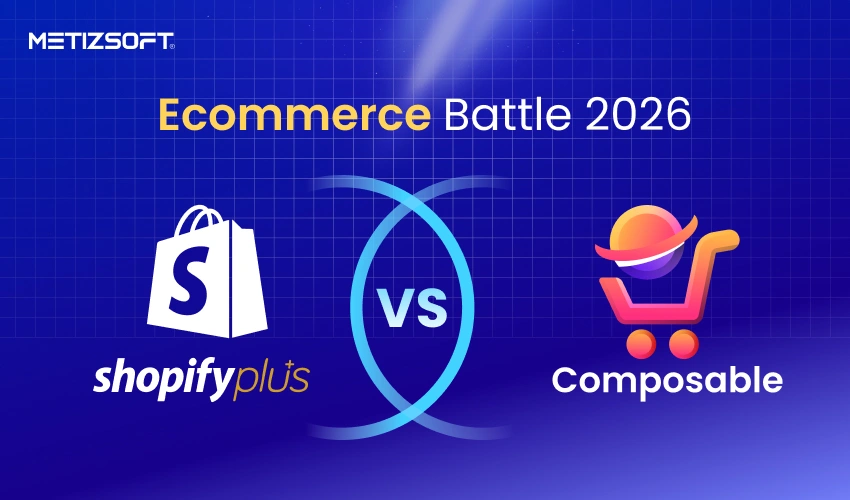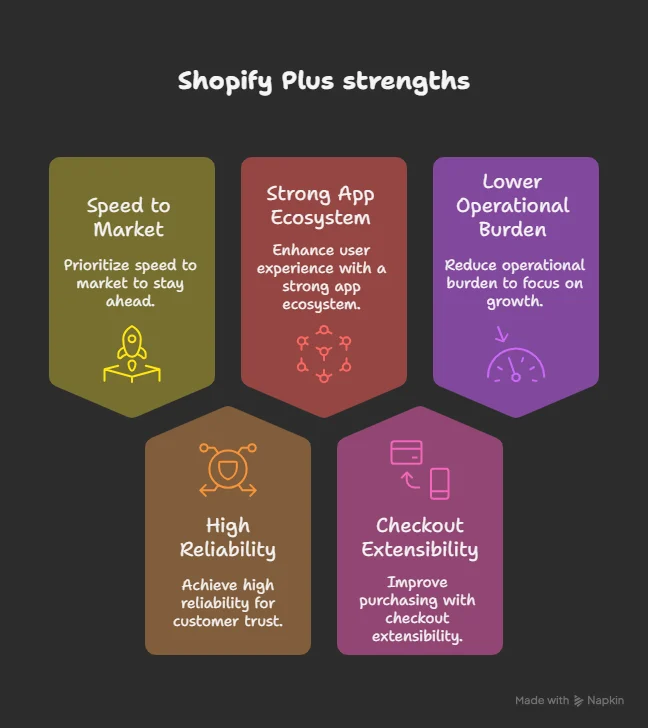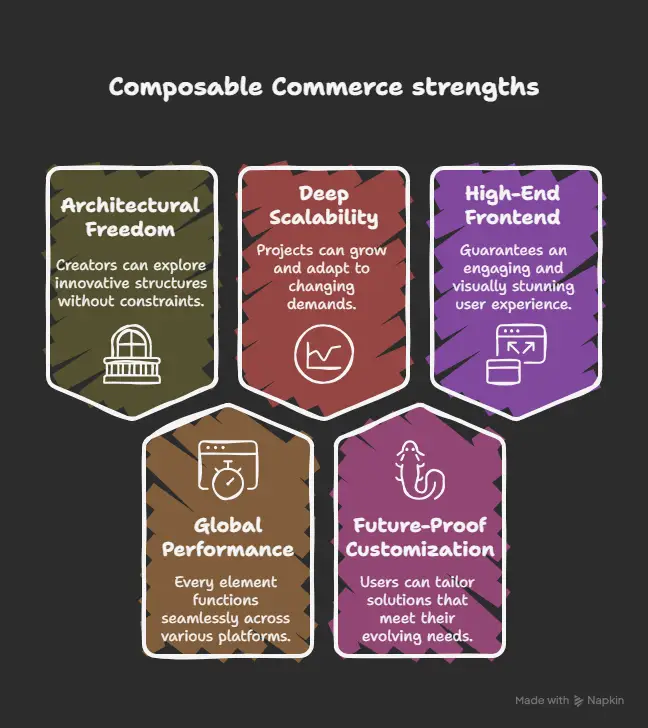
Ecommerce is moving faster than it was a few years ago. As customer expectations rise, brands are now forced to rethink how flexible, scalable, and dependable their tech stack really is. That’s why two models have been grabbing everyone’s attention lately: Shopify Plus and Composable Commerce.
Both are strong in their own way. Shopify Plus has matured into one of the most reliable enterprise ecommerce platforms, and composable commerce has become the go-to choice for brands that want total control of their architecture. But the big question for 2026 is simple: which one between the two will actually dominate?
If you’re scaling your brand, planning a migration, or looking for guidance, this blog will help you make a clear, confident decision.
Table of Contents
What Exactly Is Shopify Plus?
Shopify’s enterprise version, Shopify Plus, is built for brands handling high traffic, complex operations, and global expansion. It’s fully hosted, fast, secure, and supported by a massive ecosystem of apps and certified partners. Most importantly, it lets brands launch quickly and scale without worrying about servers, security patches, or backend maintenance.

A few real Shopify Plus strengths:
- Speed to market: Launch an enterprise store in weeks, not months
- High reliability: 99.99% uptime, even during peak sales
- Strong app ecosystem: 8,000+ apps and thousands of skilled Shopify developers
- Checkout Extensibility: Custom logic without touching core code
- Lower operational burden: Shopify handles hosting, security, and compliance
Brands like Heinz, Allbirds, Kylie Cosmetics, and many more rely on Shopify Plus because it’s stable, scalable, and adaptable.
What Is Composable Commerce?
Composable Commerce is a modern approach to building ecommerce experiences, where brands assemble their tech stack piece by piece. Instead of relying on one platform, they choose the best tools for each function, checkout, search, CMS, product data, frontend, and connect them using APIs. It’s popular among enterprises because it gives them unmatched control and enables them to build digital experiences tailored to their exact needs.

A few real Composable Commerce strengths:
- Complete architectural freedom: Choose best-in-class tools for each function
- Global performance optimization: Build region-specific stacks for faster experiences
- Deep scalability: Great for businesses with many markets, brands, and lots of products.
- Future-proof customization: Change or upgrade parts without having to start over.
- High-end frontend: Create a completely unique user experience without being limited by the platform.
Composable Commerce is very strong, but it needs skilled engineering teams, careful planning, and regular management with different vendors.
Both options are good in their own way. The choice depends on how developed your business is, the resources you have, and your growth goals.
Shopify Plus vs Composable Commerce Comparison Chart
| Area | Shopify Plus | Composable Commerce | Who wins in 2026? |
| Launch Time | Super quick. Just a few weeks, not months. | Not as fast. Requires setting up different vendors. | Shopify Plus |
| Flexibility | Great flexibility, but still has to follow Shopify rules. | Complete freedom to design however you want. | Composable Commerce |
| Total Cost | Clear subscription fee plus development expenses. | More expensive at the start and also ongoing. | Shopify Plus for mid-market |
| Maintenance | Low, Shopify handles everything. | High, your team manages vendors & APIs. | Shopify Plus |
| Scalability | Excellent out-of-the-box scalability | Enterprise-level scalability. | Tie |
| Developers Availability | Very high. Easy to hire Shopify developers. | Limited. Specialists required. | Shopify Plus |
| Best Fit | Fast-growing brands & DTC. | Global, complex, multi-brand setups. | Depend on business size |
How the ECommerce Market Is Shifting in 2026?
1. Brands want faster launches
Most companies don’t want a 6-month development cycle anymore. They want something reliable and ready to scale. Shopify Plus is built exactly for this.
2. Composable commerce is growing, but selectively
Enterprises like AT&T, Sephora, and Bang & Olufsen use composable commerce for good reason: they need that level of customization. But the mid-market rarely does.
3. Shopify is becoming more modular
Shopify Commerce Components gives brands composable-style control within Shopify’s ecosystem.
4. Developer access matters
It’s far easier to hire a Shopify Plus developer or partner with a Shopify Plus development agency than to source composable commerce specialists.
5. Cost is a major differentiator
Composable provides flexibility, but comes at a higher financial and operational cost. Shopify Plus stays predictable.
How to Decide What’s Right for You?
Choosing between the two completely depends on your requirements, business goals, and budget. But, in a simple case scenario, here’s an easy guide to help you make smart choices:
Pick Shopify Plus if:
- You want to start your store fast
- You know what products you will sell
- You like having fixed prices
- You want help from skilled Shopify developers and agencies
- You don’t want to deal with many different suppliers
- You are growing quickly and want to keep things simple on the tech side
Pick Composable Commerce if:
- You’re a global multi-brand enterprise
- You need deep customization across components
- You have a strong in-house engineering team
- You can manage multiple systems and integrations
- You want to build a long-term modular architecture
Wrapping it Up
Deciding between Shopify Plus and Composable Commerce isn’t about which is better; it’s about which one works best for your business. If quick setup, ease of use, and steady growth are important to you, Shopify Plus is the best choice. Composable Commerce, however, is meant for brands with significant complexity, international stores, multiple brands, and advanced customization needs. It offers flexibility and long-term use, but it requires time, budget, and a skilled engineering team.
Looking ahead to 2026, Shopify Plus will continue to dominate the mid-market and fast-growing DTC space because it solves the biggest problem businesses face: scaling without slowing down.
Ultimately, the right choice depends on where your brand is today and where you want it to be in the next few years. If you’re confused, talk to a Shopify Plus development agency to help clarify your choice. Both options can help your business grow; you just have to choose the one that suits your situation, not just the one that aligns with the trends.
FAQs
Is Shopify Plus scalable enough for enterprise brands?
Yes. Many global brands run on Shopify Plus with enormous traffic. Its performance and reliability are proven.
Will composable commerce replace Shopify Plus?
Not likely. Composable will grow, but Shopify Plus will continue to dominate the mid-market and DTC because it is simpler, faster, and more cost-effective.
Do I need a Shopify developer for Shopify Plus?
Yes, if you want custom features, integrations, or a high-performance theme. But there is a large talent pool available.
Is composable commerce expensive?
Generally yes. You’re managing multiple tools, vendors, APIs, and custom development. It’s powerful but not cheap.
Can Shopify Plus support headless or composable elements?
Absolutely. With Shopify Commerce Components, Shopify supports modular and headless setups.
Dive Deeper
AboutManthan Bhavsar
Related Posts
How to Build a WordPress E-commerce Store with Shopify?
Want to build an eCommerce store without involving a developer? There are many WordPress eCommerce plugins available and...
From Startup to Style Icon: How to Build a Winning Fashion Brand in 2026
From Startup to Style Icon: How to Build a Winning Fashion Brand in 2026
If you are running a mid-scale fashion brand or someone who’s thinking, “How to sell products online” or...
